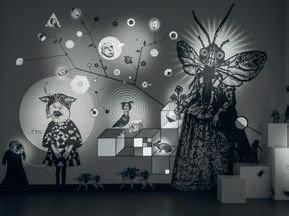
2 minute read
Beyond the Routine of Everyday Life
One might think that the designers at spatial communication have an ambivalent relationship to the concept of ”a trend.“ On one hand, the cover stories of relevant specialist media this January promise forecasts of the emerging trends for 2017, a predictable playing of the same tune, year after year. On the other hand, when I ask designers for their understanding of the term ”trend“ they are critical of the subject. Understandable! After all, no one wants to be suspected of following a trend.
In order to remain competitive as a design office, it is essential to monitor trends that by definition represent a widespread application of a design principle. Alexander Gialouris, design director at KMS Blackspace, firmly believes that studying contemporary trends requires looking beyond the design aspect and studying the total overview of the trend. ”After all, the exciting thing about our design of spatial productions is that we become a ”temporary specialist“ on a different topic with every new project. If a designer’s work creates a design trend, it is not a creative failure. Yet designers of spatial communication today remain suspicious of drawing inspiration from trends. Why?
Advertisement
Today, life in an average design office requires creatives to spend a lot of time in front of the computer. So what do agencies offer their employees for daily creative inspiration? The culture of inspiration at Blackspace consists of weekly lectures (among other things) but also leaves room for experiments in their in-house VR lab. To provide some additional inspiration Blackspace deems necessary, employees also receive an offering of what the firm calls ”Blackmoney.“ Blackmoney ensures that each employee is financially supported to freely choose external sources of inspiration, according to their individual interests. The only prerequisite is that the recipient must present impressions gained before the whole team, in order to ”broaden the horizon“ of all employees. When asked about their additional sources of creative ideas, designers repeatedly named relevant media. But the communication agency r211 in Düsseldorf, seeks and finds inspiration with topics beyond the relevant design channels – calligraphy workshops or regular city dinners, for example.

This concept also provides inspiration at the Hamburgdesign studio, I Like Birds, known for their memorable editorial images of spatial installations. I Like Birds, was founded by Susanne Kehrer and André Gröger. Both Kehrer and Gröger acknowledge that they rarely seek inspiration in their own work environment. ”This creates a very limited space for self-interpretation and associated inspiration, because a solution is already given,“ explains Gröger. ”Creative ideas find their way into art, because the art provides an opening for self-interpretation,“ adds Kehrer.
Liberation from the professional bubble allows design professionals to gain inspiration from momentary impressions of everyday life – inspiration which would otherwise be unforeseen. Professor Lutz Engelke, founder and managing director of Triad, never knows when a snapshot of daily life will happen. His camera serves him as an ”associate that archives each opportunity.“
The project ”Mécaniques Discursives“ by AntiVJ also leaves behind the routine design found in everyday life. Artists Yannick Jaquet and Fred Penelle combine seemingly opposing techniques from widely divergent eras. Gutenberg meets Big Data – the merger of wood engraving with projection mapping and data visualization succeeds! Minutely planned and absurdly poetic at the same time, ”Mécaniques Discursives“ appears like a perpetual mobile. Each of the twenty-five installations in eleven countries provides a new, independent work, thus visualizing inspiration through the design process.
”The project is an ongoing experiment. We have lots of fun together because we believe that it’s not fun to do the same thing every time, ”explains Yannick Jaquet. So where does he find inspiration? ”The absurdity of our society is an endless source of inspiration. As people, we need to find ways to mentally survive in our crazy era. Being an artist, and doing what we do, is one of the solutions we found.“ TEXT CONSTANZE










